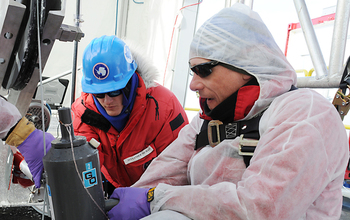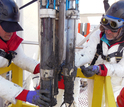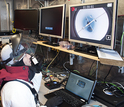News Release 14-104
Confirmed: 800 meters beneath Antarctic ice sheet, subglacial lake holds viable microbial ecosystems
Cutting-edge technology and science of the NSF-funded WISSARD project make discovery possible

Brent C. Christner (right) and Alex Michaud retrieve the first water sample from Lake Whillans.
August 20, 2014
B-roll from the WISSARD project is available by contacting Dena Headlee, dheadlee@nsf.gov / (703) 292-7739.
This material is available primarily for archival purposes. Telephone numbers or other contact information may be out of date; please see current contact information at media contacts.
In a finding that has implications for life in other extreme environments, both on Earth and elsewhere in the solar system, researchers funded by the National Science Foundation (NSF) this week published a paper confirming that the waters and sediments of a lake that lies 800 meters (2,600 feet) beneath the surface of the West Antarctic ice sheet support "viable microbial ecosystems."Given that more than 400 subglacial lakes and numerous rivers and streams are thought to exist beneath the Antarctic ice sheet, such ecosystems may be widespread and may influence the chemical and biological composition of the Southern Ocean, the vast and biologically productive sea that encircles the continent.
According to Brent C. Christner, the paper's lead author and a researcher with the NSF-funded Whillans Ice Stream Subglacial Access Research Drilling (WISSARD) project, "Hidden beneath a half-mile of ice in Antarctica is an unexplored part of our biosphere. WISSARD has provided a glimpse of the nature of microbial life that may lurk under more than 5 million square miles of ice sheet."
Analysis of the samples taken from subglacial Lake Whillans, the researchers indicate, show that the water contains a diverse microbial community, many members of which can mine rocks for energy and use carbon dioxide as their source of carbon.
Added John Priscu, a WISSARD scientist at Montana State University, Bozeman and a co-author on the paper, the Antarctic subglacial environment is our planet's largest wetland, one dominated completely by microorganisms.
The WISSARD findings are published in the Aug. 21 issue of the journal Nature by scientists and students affiliated with WISSARD, which is a collaboration involving researchers at numerous institutions across the United States.
Christner is a professor of biology at Louisiana State University (LSU). Other co-authors on the paper include students and researchers from LSU; the University of Venice in Italy; New York University; the Scripps Institution of Oceanography; St. Olaf College in Minnesota; the University of Tennessee; and Aberystwyth University in the United Kingdom.
NSF, which manages the U.S. Antarctic Program through its Division of Polar Programs, provided more than $10 million in grants as part of NSF's American Recovery and Reinvestment Act of 2009 portfolio to support the WISSARD science and development of related technologies.
NASA's Cryospheric Sciences Program, the National Oceanic and Atmospheric Administration and the private Gordon and Betty Moore Foundation also provided support for the project.
The WISSARD team made scientific and engineering history in late January of 2013 when they used clean hot-water drilling technology to access subglacial Lake Whillans. This permitted the retrieval of pristine water and sediment samples that had been isolated from direct contact with the atmosphere for many thousands of years.
The interdisciplinary WISSARD research team included groups of experts in the following areas of science: life in icy environments, led by Priscu; glacial geology, led by Ross Powell, of Northern Illinois University; and glacial hydrology, led by Slawek Tulaczyk, of the University of California, Santa Cruz.
Definitive evidence of life in subglacial lakes
The realization that a vast aquatic system of rivers and lakes exists beneath the ice in Antarctica has spurred investigations to examine the effect on ice-sheet stability and the habitability of environments at the bed. The latest WISSARD announcement is the first to provide definitive evidence that a functional microbial ecosystem exists beneath the Antarctic ice sheet, confirming more than a decade of speculation about life in this environment.
Using various methods, including airborne radar surveys, scientists have built a knowledge base about Antarctica's subglacial hydrological system over the past 40 years. The largest of the subglacial lakes, subglacial Lake Vostok in East Antarctica, is one of the largest lakes on our planet in terms of volume and depth and has been isolated beneath the ice sheet for more than 10 million years.
Samples of microbes from Lake Vostok have been collected indirectly by examining ice collected above the liquid part of the Lake- ice that refroze--accreted--on the bottom of the ice sheet.
These samples, which were described in 1999 by Priscu, the chief scientist of the WISSARD project, and David Karl of the University of Hawaii, presented the first evidence for life beneath the huge Antarctic ice sheet.
However, the drilling techniques used to retrieve the Vostok samples and the low amount of microbial biomass present in the samples had called into question previous studies that concluded the lake supports a living ecosystem.
The WISSARD team drilled into subglacial Lake Whillans using a clean hot-water drill and incorporated rigorous measures to avoid the introduction of foreign material into the lake.
The approach to drilling was guided by recommendations in the 2007 National Research Council-sponsored report, "Exploration of Antarctic Subglacial Aquatic Environments: Environmental and Scientific Stewardship," aimed to protect these unique environments from contamination.
A team of engineers and technicians directed by Frank Rack of the University of Nebraska-Lincoln, designed and fabricated the specialized hot-water drill that was fitted with a filtration and germicidal UV system to prevent contamination of the subglacial environment and to recover clean samples for microbial analyses. In addition, the numerous customized scientific samplers and instruments used for this project were also carefully cleaned before being lowered into the borehole through the ice and into the lake.
A major concern that drove the clean-drilling techniques and protocols is that it is still unclear how interconnected the subglacial aquatic system is. Researchers did not want to risk contaminating the entire system through their sampling of one body of water.
The newly published paper also raises a separate issue of the connectivity of Lake Whillans to the wider global ecosystem, noting that the lake is part of network of three major reservoirs beneath the Whillans Ice Stream that regulate the transportation of water to a subglacial estuary--an area where fresh and salt water mix--which links the subglacial aquatic system to the ocean beneath the Ross Ice Shelf.
"Given the prevalence of subglacial water in Antarctica," the researchers write, "our data...lead us to contend that aquatic microbial systems are common features of the subsurface environment that exists beneath the ... Antarctic ice sheet."
-NSF-
-
Ross Powell (left) and Reed Scherer recover an instrument from subglacial Lake Whillans.
Credit and Larger Version -
Ken Mankoff of the WISSARD project monitors a borehole camera.
Credit and Larger Version -
Colonies of bacteria cultured from samples of the water column from subglacial Lake Whillans.
Credit and Larger Version -
View Video
NSF-funded WISSARD team discovers microbial life in Antarctic subglacial Lake Whillans.
Credit and Larger Version
Media Contacts
Peter West, NSF, (703) 292-7530, email: pwest@nsf.gov
Dawn Jenkins, Louisiana State University, (225) 578-2935, email: djenkins1@lsu.edu
Evelyn Boswell, Montana State University, (406) 994-5135, email: evelynb@montana.edu
Whitney Heins, University of Tennessee, Knoxville, (865) 974-5460, email: wheins@utk.edu
James Devitt, New York University, (212) 998-6808, email: james.devitt@nyu.edu
Principal Investigators
Brent C. Christner, Louisiana State University, (225) 578-1734, email: xner@lsu.edu
John C. Priscu, Montana State University, (406) 994-3250, email: jpriscu@montana.edu
The U.S. National Science Foundation propels the nation forward by advancing fundamental research in all fields of science and engineering. NSF supports research and people by providing facilities, instruments and funding to support their ingenuity and sustain the U.S. as a global leader in research and innovation. With a fiscal year 2023 budget of $9.5 billion, NSF funds reach all 50 states through grants to nearly 2,000 colleges, universities and institutions. Each year, NSF receives more than 40,000 competitive proposals and makes about 11,000 new awards. Those awards include support for cooperative research with industry, Arctic and Antarctic research and operations, and U.S. participation in international scientific efforts.
Connect with us online
NSF website: nsf.gov
NSF News: nsf.gov/news
For News Media: nsf.gov/news/newsroom
Statistics: nsf.gov/statistics/
Awards database: nsf.gov/awardsearch/
Follow us on social
Twitter: twitter.com/NSF
Facebook: facebook.com/US.NSF
Instagram: instagram.com/nsfgov






_r.jpg)